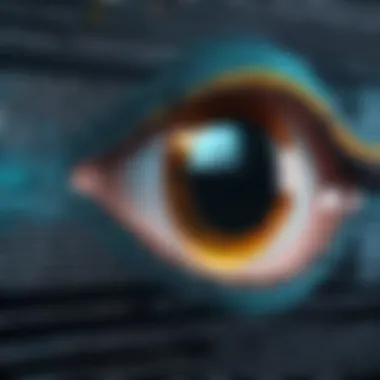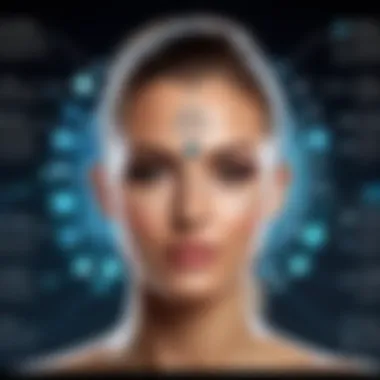Unlocking the Power of Word OCR from Images


Intro
Optical Character Recognition (OCR) has transformed the way we work with printed and handwritten documents. It allows users to extract text from images and convert it into editable formats such as Microsoft Word. This is particularly relevant in an age where information is abundant, yet harnessing that information often requires efficient processing. OCR tools use complex algorithms and methodologies to recognize characters within images, making them valuable resources across various sectors.
This guide will explore OCR technology in detail, illuminating its potential and practical applications. From understanding its key features to analyzing performance metrics, this article serves as a crucial resource for tech enthusiasts and industry professionals alike.
Product Overview
When discussing OCR tools, it is essential to examine several aspects that define their usability and effectiveness. Here, we will outline key features and specifications that set these tools apart from conventional methods of text extraction.
Key Features
- Text Extraction: The primary function of OCR software is to convert images into editable text. This includes scanned documents, photographs, and even handwritten notes.
- Multi-Language Support: Advanced OCR tools can recognize characters in multiple languages, broadening their usability for international audiences.
- Image Preprocessing: Efficient OCR software often includes features to enhance the quality of the images before processing. This can reduce errors and improve recognition rates.
- Export Options: Many OCR applications provide various export formats, making it easy for users to save their text in preferred file types such as DOCX, PDF, or plain text.
Specifications
OCR software varies widely in specifications, including processing speed, accuracy, and system requirements. Users should consider these factors when selecting an appropriate tool.
- Accuracy Rate: The best OCR tools boast accuracy rates of up to 99%, depending on the clarity and quality of the source image.
- Processing Speed: Speed is often critical, especially when scanning large batches of documents. High-performance OCR solutions can process multiple pages in seconds.
- System Compatibility: Most OCR applications are compatible with various operating systems, including Windows, macOS, and Linux.
Performance Analysis
Evaluating the performance of OCR tools is critical for understanding their value. This includes assessing speed, efficiency, and overall productivity.
Speed and Efficiency
In real-world applications, the speed of an OCR tool determines its utility. A slower tool can hinder workflow, especially in demanding environments. Modern OCR software utilizes advanced algorithms allowing them to process documents rapidly without compromising quality. The efficiency of these programs also reflects their capability to handle different input types, whether monochrome or color images.
Accuracy and Usability
Accuracy is paramount. Users expect OCR tools to deliver precise text extraction, minimizing errors caused by poor image quality or complex fonts. Tools with integrated image preprocessing capabilities can enhance usability significantly.
"High accuracy in OCR translates into time saved during document processing and reduces the need for manual corrections."
As we proceed, the subsequent sections will delve deeper into various techniques employed in OCR, its practical applications across different fields, and methodologies for optimizing results.
Prelude to OCR Technology
Optical Character Recognition (OCR) is a cornerstone in the realm of digital document processing. Its significance stretches well beyond mere text extraction; it revolutionizes how we interact with information captured in an image format. With the continuous expansion of data, the need for efficient and accurate methods to convert physical documents into editable formats is paramount. This article will serve as a comprehensive guide, illustrating how OCR technology functions and its relevance in converting images into editable Word documents.
Defining Optical Character Recognition
At its core, Optical Character Recognition refers to the capability of a machine to identify and convert different types of written characters into a machine-readable format. This technology is not limited to just printed text but can also extend to handwritten forms. The diverse applications of OCR illuminate its capabilities, from scanning grocery receipts to converting entire books into digital formats, making information more accessible and manageable.
Moreover, OCR acts as an intermediary for the digitization process, facilitating a seamless transition from physical media to digital storage. This transformation has implications not only for individual users but also for organizations seeking to streamline workflows and reduce manual data entry errors. Thus, understanding the intricacies of OCR is vital as we navigate an increasingly digital world.
History and Evolution of OCR
The journey of OCR technology began in the early 20th century. Initial attempts at machine reading were rudimentary and often failed under varying conditions. However, as computational capabilities advanced, so did OCR. Early systems primarily recognized printed characters. These systems relied heavily on pattern recognition techniques, using templates for matching characters.
The breakthrough in OCR technology arrived with the adoption of machine learning. In the 1990s, the introduction of algorithms that allowed software to learn from datasets marked a turning point. Newer models incorporated various types of fonts and even attempted to recognize handwritten letters. The advent of deep learning in the 2010s further refined OCR's ability to detect and process diverse character sets, significantly improving its accuracy.
Today, OCR is an integral part of many processes across various fields such as healthcare, banking, and education. Its role in digital transformation continues to evolve, ensuring easy information retrieval and streamlining productivity. As OCR technology progresses, its potential applications are becoming even more expansive, positioning it as a crucial tool in managing our information-rich environments.
How OCR Works
Understanding how OCR works is critical for appreciating its capabilities and challenges. OCR technology transforms images of text into editable and searchable formats. This section delves into its mechanics, providing clarity on image processing and character recognition.


The Technical Underpinnings of OCR
At its core, OCR relies on a combination of computer science and linguistics. It employs algorithms that identify and convert characters within an image. These algorithms analyze the structure of letters, identifying features to decode text accurately. Understanding these underpinnings helps users grasp how OCR can be optimized for various languages and types of documents. The interplay between image processing and character analysis creates the foundation for effective text extraction.
Image Preprocessing Techniques
Before actual character recognition happens, images must be prepared. This preparation involves several preprocessing techniques that enhance quality and ensure accuracy.
Noise Reduction
Noise reduction is pivotal in improving the quality of an image. This process minimizes unwanted variations that can obscure text. By clarifying the background and smoothing out distortions, noise reduction serves to enhance the visibility of characters. A key characteristic of noise reduction is its ability to apply filters, making it a popular choice. However, improper application can remove important features of letters, potentially leading to misrecognition.
Image Rescaling
Image rescaling adjusts the dimensions of an image to improve recognizability. By increasing size, OCR tools can analyze text more effectively. This resizing enhances detail, crucial for recognizing small or intricate fonts. Rescaling is beneficial because it helps align the text to fit the OCR algorithms' requirements. Nonetheless, excessive changes in size can distort the image, affecting text extraction accuracy.
Brightness and Contrast Adjustment
Brightness and contrast adjustments improve text visibility against a background. By altering these settings, characters can become more distinct. This adjustment is beneficial, especially in images with poor lighting. Highlights ensure that the OCR engine can detect the boundaries of characters clearly. However, too much adjustment can lead to loss of detail, which could hinder recognition outcomes.
Character Recognition and Analysis
Once images are preprocessed, they undergo character recognition. This is where the real magic of OCR takes place.
Pattern Recognition
Pattern recognition is essential for deciphering individual characters. The technology identifies and matches shapes of letters with known patterns from its training set. Recognizing these patterns allows the system to understand text accurately. The power of pattern recognition lies in its adaptability, as it can improve through usage. However, its effectiveness can dip with unusual fonts or characters that have not been adequately represented in the training data.
Feature Extraction
Feature extraction involves isolating distinct characteristics of letters, such as lines and curves. By categorizing these features, OCR systems can enhance their recognition capabilities. This approach is beneficial as it allows finer details to contribute to overall accuracy. Nevertheless, if critical features are missed, the recognition process may lead to errors in output.
Machine Learning Models
Machine learning models serve as sophisticated frameworks for character recognition. These models analyze a vast array of data, learning from examples to improve their accuracy. The adaptation to various fonts and styles makes machine learning a powerful choice for OCR applications. However, they require substantial training data. This can pose challenges when dealing with obscure text styles or less common languages.
Applications of Word OCR
Optical Character Recognition (OCR) plays a crucial role in various sectors. Its ability to convert images into editable formats enhances efficiency and accessibility. Understanding the applications of word OCR helps identify its significance in modern society. The benefits such as time savings, improved accuracy, and the capacity to handle large volumes of text make it essential tool across different industries.
Document Digitization and Archiving
One of the primary applications of word OCR is in document digitization and archiving. Businesses and organizations often deal with vast amounts of paper documents. Converting these printed materials to digital formats facilitates better storage, retrieval, and management. By implementing OCR, entities can scan paper files and transform them into searchable and editable documents. This leads to significant improvements in workflow and data access.
Data Entry Automation
Another significant application of word OCR is data entry automation. Manual data entry is not only time-consuming but also prone to human error. With OCR technology, scanned documents can be processed quickly and accurately. This automation reduces labor costs and increases productivity. For instance, invoices and forms scanned via OCR can have their data extracted, processed, and stored without extensive human intervention.
Accessibility Enhancement
OCR technology is also vital for enhancing accessibility. It allows individuals with visual impairments to access printed content. Text extracted from images can be read aloud using text-to-speech software. This application creates a more inclusive environment, ensuring that those with disabilities have equal access to information. Additionally, OCR contributes to making educational materials available to a wider audience, reinforcing the importance of accessible content.
Integration with Other Technologies
The integration of OCR with other technologies further expands its applications.
Artificial Intelligence


Artificial intelligence (AI) enhances OCR by applying intelligent algorithms to improve accuracy. These algorithms can help predict and interpret text better, especially in poor quality images. A key characteristic of AI in this context is its ability to learn from data, which results in continual improvements in recognition capabilities. This makes it a popular choice for businesses seeking reliable text extraction solutions. However, the unique feature of AI is its diverse applicability, though it can sometimes require extensive training data to reach optimal performance.
Cloud Computing
Cloud computing plays a significant role in modern OCR applications. By utilizing cloud platforms, users can access powerful OCR tools without the need for high-end local hardware. This flexibility allows for remote processing of documents and easy sharing of extracted data. A key characteristic is scalability, enabling companies to expand their usage as needed. The unique feature here is that cloud OCR services can often integrate with existing software solutions, bringing additional advantages to workflow automation. However, reliance on internet connectivity can be a disadvantage in some cases.
Mobile Applications
Mobile applications that incorporate OCR are becoming increasingly common. These apps allow users to capture text on-the-go, converting images directly from their smartphones into editable documents. A key feature of mobile OCR applications is convenience; they enable quick access and editing of text anywhere. Moreover, these applications often come equipped with user-friendly interfaces, making them accessible to non-technical users. The challenge lies in consistent recognition accuracy across various device cameras, where lighting and resolution may affect results.
"The integration of OCR with AI, cloud computing, and mobile applications illustrates how adapted technology can meet individual and organizational needs."
Common Challenges in OCR
Optical Character Recognition (OCR) has undoubtedly transformed the way we handle text from images. However, despite its many advantages, several challenges persist in ensuring effective text extraction. By understanding these challenges, users can better prepare and optimize their processes for successful OCR outcomes. This section addresses key elements in OCR, examining common problems that arise and offering insight into considerations that can mitigate these issues.
Variability in Text Styles
One of the major hurdles in OCR technology is variability in text styles. Different fonts, sizes, and formatting can significantly impact the recognition process. For example, decorative or handwritten fonts are often not recognized accurately by standard OCR algorithms, resulting in errors. Some key points to consider include:
- Typeface Variations: Distinct typefaces have unique characteristics that can confuse OCR systems. Serif fonts may pose difficulties compared to sans-serif fonts due to their intricate designs.
- Stylistic Elements: Text styles like bold, italics, or underlining can affect the character recognition capability. OCR tools may need time to adapt to these changes.
- Overlapping Characters: In images where text is close together, such as on posters or book covers, the OCR may misinterpret adjacent letters, merging them into a single character.
Being aware of these factors is crucial for choosing the right OCR tool and adjusting expectations regarding accuracy.
Quality of Source Images
The quality of the input images is perhaps one of the most critical determinants of OCR success. High-quality images yield better results, while poor-quality ones lead to significant recognition errors. A few considerations regarding image quality include:
- Resolution: Low-resolution images, typically below 300 DPI, can hinder the OCR's ability to distinguish characters correctly. For best results, images should be clear and sharp.
- Lighting Conditions: Poor lighting can create shadows, leading to obscured text. Ensure images are well-lit and evenly illuminated.
- Image Distortions: Skewed or warped images, such as those taken at an angle, complicate character recognition. Straightening and adjusting perspective can aid clarity.
Evaluating these aspects before processing images can substantially improve results.
Language and Font Limitations
Another significant concern in OCR technology is language and font limitations. Many OCR systems have specific capabilities regarding the languages and fonts they can effectively process. This limitation can present challenges, especially for users with multilingual needs. Key points include:
- Character Sets: Some OCR tools are optimized for specific languages and may not support characters outside their predefined sets, leading to errors in text recognition.
- Complex Scripts: Languages that use complex scripts, such as Arabic or Chinese, often require specialized OCR solutions that understand unique character formations.
- Font Availability: Not all OCR tools can handle a variety of fonts; thus, choosing one that adequately accommodates the fonts used in documents is essential.
Evaluating OCR Tools
Evaluating OCR tools is essential to determine which software best fits your needs. The landscape of OCR tools is vast, featuring different functionalities that cater to various applications. Selecting the right tool impacts the efficiency of text extraction processes and how well the software meets user demands. This section will outline the most significant features to consider when assessing OCR tools.
Features to Consider
Accuracy and Speed
Accuracy and speed are two of the most critical factors in OCR technology. The ability to correctly identify characters and words from images directly influences the usability of the output. High accuracy means fewer manual corrections post-recognition, saving valuable time. A tool that operates quickly allows users to process large volumes of documents efficiently.
For example, some tools employ advanced algorithms for recognition. They can process a page in seconds while ensuring high accuracy levels. However, a trade-off often exists between speed and accuracy. High-speed operations can sometimes lower accuracy rates. Hence, users should balance these two attributes according to their specific requirements.
Supported File Formats
Supported file formats determine the versatility of an OCR tool. A software that recognizes various formats, such as PDF, JPG, or TIFF, can cater to broader needs. This characteristic is particularly valuable in environments where documents exist in multiple types. A tool that supports more formats may allow easier integration into workflows without extensive conversions beforehand.
Additionally, having the capacity to handle different languages enhances a tool's utility. This is beneficial for users working with diverse content. However, it's essential to check if the quality of recognition remains high across various formats and languages since this can sometimes be inconsistent.
User Interface and Experience


User interface and experience (UI/UX) are vital for making the OCR tool effective. A well-designed interface enhances usability, increasing productivity by minimizing training time. An intuitive UI means that users can quickly navigate features and settings, making the workflow smoother.
Some OCR tools offer customization options, allowing users to personalize the interface according to preferences. This feature can improve user engagement and satisfaction. However, a complex interface might deter new users, causing frustration. Therefore, finding a balance between advanced features and simplicity is crucial for any OCR tool.
Comparison of Popular OCR Tools
When assessing OCR tools, comparing popular options provides valuable insights into their strengths and limitations.
Adobe Acrobat
Adobe Acrobat DC is renowned for its comprehensive PDF editing features. It integrates OCR capabilities, allowing users to convert scanned documents into editable and searchable files. A major advantage is its seamless integration with Adobe's ecosystem, providing extra tools for document management.
However, it comes with a subscription cost that may not be suitable for all users. While it offers a robust solution for many, those needing simple features might find it over-complicated.
Tesseract OCR
Tesseract OCR stands out as a free, open-source option. It has gained popularity for its flexibility and support for numerous languages. Developers appreciate its ability to be integrated into various applications.
However, Tesseract's user interface is not as user-friendly as some paid alternatives. It may require technical knowledge for effective use, limiting accessibility for non-experts. Users should weigh the advantages of customization against the potential learning curve.
ABBYY FineReader
ABBYY FineReader is often praised for its precision in text recognition and broad file format support. It provides comprehensive capabilities for both individuals and businesses, including collaboration features. FineReader excels in converting documents while maintaining formatting and layout.
On the downside, its cost can be a barrier for small businesses or individual users. While the quality of output is extremely high, potential users must consider their budget and overall needs before committing to this tool.
"Selecting an OCR tool involves careful consideration of features like accuracy, speed, and user experience."
Employing the right OCR technology can streamline document processing and enhance productivity when correctly assessed. By evaluating specific characteristics and comparing tools, users can make informed decisions that align with their unique demands.
Future Prospects of OCR Technology
The field of Optical Character Recognition (OCR) is on the brink of significant advancement, driven largely by developments in machine learning and artificial intelligence. The coming years promise a transformation in how OCR is utilized, emphasizing both efficiency and accuracy. As technology evolves, the integration of OCR with other innovative systems heralds new applications and enhances existing functionalities. This prospect not only excites researchers and developers but also presents opportunities for industries that leverage text recognition technology.
Advancements in Machine Learning and AI
Machine learning has reshaped the landscape of OCR, enabling systems to learn and adapt to various text styles and formats. The incorporation of deep learning techniques enhances accuracy, as they allow OCR systems to process large datasets and improve recognition over time. Recent algorithms have shown a remarkable ability to decipher even poorly rendered or stylized fonts, which was a challenge in the early days of OCR.
Developers are increasingly focusing on developing customized models that can be fine-tuned for specific tasks. For instance, training models on medical documents or legal texts increases the precision of character recognition in those domains. This targeted approach not only asserts reliability but also saves time for users by minimizing the need for manual corrections.
Furthermore, the shift from directional features to holistic approaches in analyzing images is notable. Instead of merely recognizing characters, newer models evaluate the context of the whole document, allowing for better interpretation of meanings and nuances.
Integration with Augmented Reality
The integration of OCR technology with augmented reality (AR) is a groundbreaking development. This combination provides users with interactive ways to engage with text in real-time. Imagine using an AR application that scans and recognizes text from a physical book and displays it as an editable document on your device. Such functionality can bridge the gap between physical and digital spaces, creating seamless transitions for users.
This technology can also be applied in multilingual environments. For example, when users point their devices at foreign text, an OCR system can convert and overlay translations in real-time. This application holds tremendous potential in tourism, education, and international business contexts.
The future of OCR technology is not only about improving basic functionality. It is about creating interconnected experiences that can redefine how users interact with information. As it stands, the innovation in OCR continues to advance, promising to deliver enhanced capabilities that cater to the demands of various industries and individual users alike.
"With the continuous advancements in OCR technology, the barriers between digital and physical text will diminish, heralding a new era for information accessibility and interaction."
By closely observing these trends and developments, one can grasp the essential role that OCR will play in the democratization of information. Text recognition technology will evolve into an indispensable tool that influences numerous facets of daily life and professional practice.
Culmination
The conclusion of this article reiterates the significance of Optical Character Recognition (OCR) technology in the modern digital landscape. In this guide, we have thoroughly explored various facets of OCR, including its technical workings, applications, challenges, and future directions.
Summarizing Key Takeaways
To encapsulate the key points discussed:
- Definition and Functionality: OCR is fundamentally about transforming images or scanned documents into editable formats. This is crucial in fields like document management and digital archiving.
- Technological Underpinnings: The article highlighted sophisticated image preprocessing methods, including noise reduction and feature extraction, essential for improving recognition accuracy.
- Diverse Applications: OCR finds utility across multiple sectors, significantly automating data entry tasks and enhancing accessibility for individuals with disabilities.
- Challenges: Key hurdles such as variability in fonts, the quality of source images, and multilingual support were identified. Addressing these issues remains vital for optimization.
- Future Directions: Advancements in machine learning and potential integrations with technologies like augmented reality suggest that OCR is poised for continued evolution.
"OCR has transcended its initial capabilities, reflecting its critical role in streamlining processes across various industries."
Final Thoughts on the Importance of OCR
The importance of OCR lies in its transformative ability to bridge the gap between physical text and digital accessibility. As technology progresses, OCR continues to adapt, making it an indispensable tool in a world that demands efficiency and data manipulation. For tech-savvy individuals and industry professionals, understanding the intricacies of OCR can foster better decision-making concerning its implementation. Moreover, recognizing both its potential benefits and inherent limitations allows for a more strategic approach to its use in real-world applications. Therefore, OCR technology not only represents a functional advancement in text recognition but also embodies a vital resource for innovative problem-solving across diverse domains.



